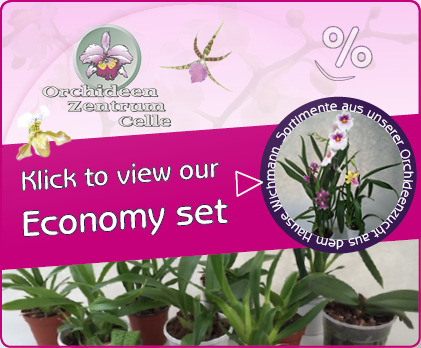Vermehrung von Orchideen - Wie können Orchideen vermehrt werden?
There are many ways to multiply orchids. Whether in the nursery or in the laboratory, by pollination or without, orchid cultivation is complex and time-consuming. A women's shoe that we buy in the nursery for Mother's Day is sometimes several years old. Only thanks to modern propagation strategies are orchids more affordable than ever. Incidentally, quite a few procedures produce offspring that are clones of their own parents. This happens entirely without genetic engineering, even in nature.
Reproduction in nature
Like other flowering plants, an orchid, in its natural habitat, makes ignorant insects to breed. Their flowers are hermaphrodite, so they have both male sexual organs, the pollen, and female, the pistil. So also the women's shoe. Lured by the splendor of colors, bees plop into the sack-like shoe of the flower. Since they cannot crawl out again in the same way, they have to crawl out in a different place, past the pollen sacks and the scar. They casually pollinate the flower and produce the next generation of orchids.
Did you know that the Polychilos subspecies of the Phalaenopsis orchids has developed a unique mechanism to support the ripening of the seeds in a special way? After an insect has fertilized the flower, it does not wither, but undergoes a metamorphosis to a smaller green flower that is capable of photosynthesis and thus contributes to the energy requirement of seed ripening.
Orchids reproduce not only through pollination but also through offshoots, so-called Kindel. In nature, they do this especially when they are in a bad way and they want to quickly ensure the continued existence of their species.
The generative multiplication
When orchids became popular as houseplants in the 18th century, ornamental gardeners still didn't know how to grow them. For this reason, traders had to import every single plant from their country of origin. This made the exotic plant extremely exclusive and almost priceless. The decisive trick was only discovered about 150 years later: the microscopic orchid seeds can only germinate thanks to a symbiosis with a filamentous fungus. Immediately after germination, it penetrates the seeds and serves as a source of nutrients until the seedlings carry out photosynthesis and can feed themselves. In modern plant breeding, it is now possible to provide the seeds with the nutrients asymbiotic without fungus by cultivating them on special nutrient media.
What makes orchid cultivation so complex is not just the germination, but also the extraction of the seeds. In nature, insects help with pollination, in the greenhouse the pollen must be applied to the scar by hand. A laborious and time-consuming job. Patience is required. It takes about eight to twelve months for the seed pods to ripen. But it's worth the wait, every capsule contains hundreds of thousands or even millions of dust-fine seeds. They are harvested a few weeks before the time comes, because at the end of the ripening process the capsules burst. If it bursts, you risk not only the loss of valuable seeds, but also that they become contaminated with pathogens. The seeds are then sown on nutrient media under sterile conditions and remain in a special laboratory for about two years after germination before returning to the nursery. There they are cultivated for another three to six years until they are about to bloom and can be sold in stores.
Pollination is a rather old-fashioned way of crossing orchids. They are usually carried out when new hybrid varieties are to be created. In contrast to natural forms, hybrid varieties are hybrids from two different parent plants, from which one desires particularly good offspring. Most of the commercially available varieties are hybrids that are cloned using modern methods of vegetative propagation.
The vegetative propagation
In order to shorten the tedious propagation process, breeders developed clever methods to propagate orchids without pollination, i.e. vegetatively. In tissue culture, for example, plant material from leaf tips, root tips or shoot eyes of the stems is propagated. This contains the stem cells of the orchids, which can be grown on whole plants in a laboratory. This method is not only more controllable and economical than conventional pollination, it creates genetically identical offspring that have exactly the same properties as their mother plant. In this way, the best and most beautiful orchids, for example special, flowering, robust and fast-growing specimens, can be produced in huge numbers in a relatively simple manner.
Thanks to this asexual propagation strategy, orchid cultivation is now easier, faster and, above all, much cheaper. That's why you can get them in the supermarket for a few euros these days.
Kindel
However, there are also natural forms of asexual reproduction. To spread, orchids sometimes train Kindel. These miniature orchids are created on the shoot eyes of the flower stems and are rejected as soon as they have sufficiently strong roots. Since pollination is not required to train Kindel, they are not crosses, but small clones of the mother plant. It happens that an orchid forms kindel when it is so stressed that it fears for its survival. In that case, she puts all her energy into the next generation to ensure the survival of her genes. However, this does not always have to be the cause, some varieties of orchid breeders are simply predisposed to often training Kindel.
Planting offshoots is a great way to rejuvenate your orchid. Wrap the delicate roots of the offshoot with damp sphagnum moss to help them develop. Use a disinfected knife to cut the nursery off the mother plant if it has at least two leaves and the roots are three to five centimeters long. In fine-grained substrate in a shady place, it will thrive in the coming months.
Multiplication by division
Cultivars such as Cymbidium, Oncidium or Brassia, the sympodial sphagnum moss, can therefore be propagated by division. With sympodial growth, the underground rhizome always forms new, individual shoots or bulbs. If it gets tight in the pot at some point, they can be separated into several independent plants by cutting the rhizome at the appropriate place. You can also do this at home.
Species like Angraecum or Vanda grow monopodially and have only one sprout on which new leaves and flowers sprout. They are not propagated by division unless they have grown too large and have already rooted side shoots. Since you get offspring without previous pollination when dividing orchids, this form of propagation is also called asexual.
Cuttage
Terrestrial orchids can also be propagated classically using cuttings. Gardeners mainly use this method for Vanilla planifolia. For the propagation of cuttings you cut off the flowering tendrils of the vanilla, shorten it to ten to fifteen centimeters with three to four leaves. In the moist growing substrate with a thin wooden stick as a support, the cuttings quickly root themselves and grow again into large magnificent orchids.



 ... to newsletter subscription
... to newsletter subscription ... to see all economy sets
... to see all economy sets


























